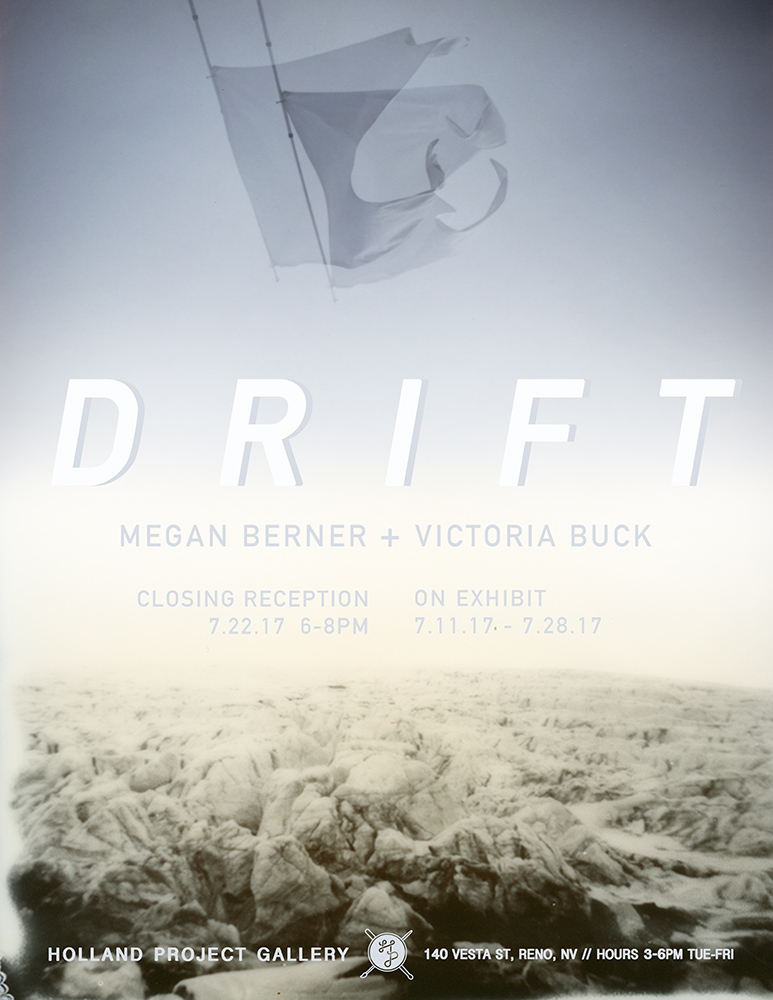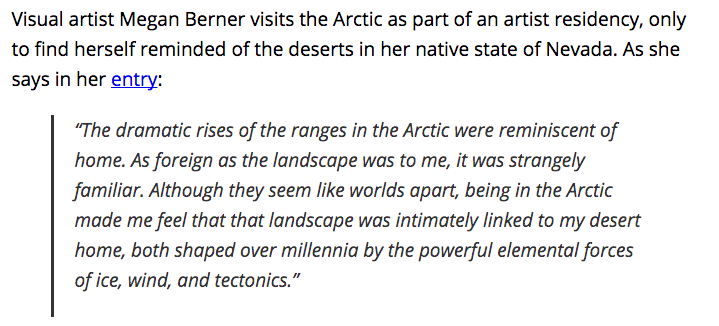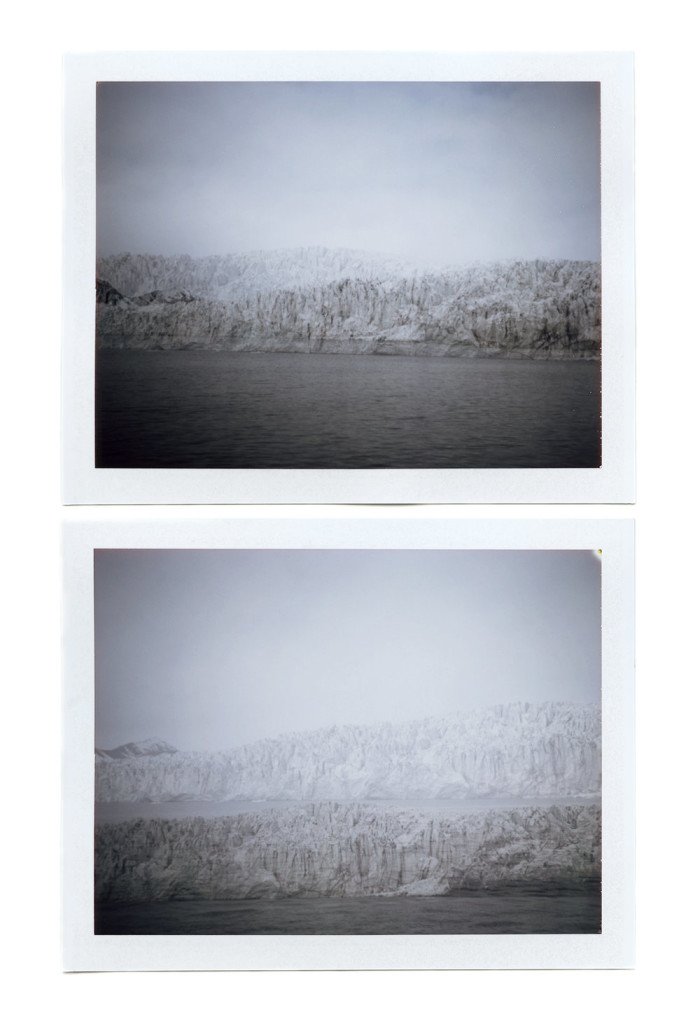Drift, up now in the Holland Gallery, features work from Megan Berner and Victoria Buck and centers around their trip to the Arctic Circle as a part of an artist residency program. We asked Megan a little bit about her journey traveling to the Arctic, how it impacted her work and practices, and how the landscape both challenged and inspired her. Check it out!
How did you get there? And where is ‘there’?
Well, I took a plane to Longyearbyen on the archipelago of Svalbard, Norway. Svalbard is in the Arctic Circle between 74º and 81º north. In Longyearbyen, I got on the tall ship Antigua–a three-masted sailing ship–with 28 other artists and writers and we sailed around the Northwest side of Spitsbergen, the largest island in the archipelago, over a two week period.
What was the most surprising or unexpected experience you had?
I was there during the summer solstice and thought I would love the 24-hour sunlight. It made for great photographs and the light did change with the weather but, it felt very manic and messed with any normal sense of the passing of time in any way that I am used to. In some ways, that heightened the surreal aspect of the landscape and the experience but it kind of makes you a little crazy. I don’t think you can prepare for the magnitude of the landscape in a place like that and how it will affect you. It made me feel very small.
What will you take away as the coolest or most impactful moment of the trip?
So many amazing things that happened during that trip. Being in close quarters like that with a bunch of other creatives was intensely stimulating and affirming. I met a lot of great people whose work and friendship will continue to make an impact on my life and my own art. Just being surrounded by that much nature and being in a remote area with no distraction (2 weeks without phones/internet/connection to the outside world) made it easy to be present and experience things with a different kind of attention. Though the trip was only 2 weeks, it felt like a much larger chunk of time. Our encounters with wildlife were especially exciting–we were surrounded by three blue whales one afternoon who were very curious about us and stayed close. One in particular (it was bigger than our ship, I’m pretty sure) kept popping up and spraying us with its blowhole while inspecting the ship. It felt like the whale was staring right at us.
Can you share any interesting facts you learned?
Learning about the town of Pyramiden was super interesting and gave some background into the activity on the island. (This is a super cool video to check out if you are interested in learning more about this place). We also visited the research town of Ny Alesund where 10 countries have research stations centered around environmental and earth sciences. The captain of our ship has been sailing around the area every summer for the last 9 years and told us that he could see that the glaciers were receding.
Did this journey or the experience change your art, your practices or processes, or push you to do something new?
It has taken a long time for a lot of this experience to sink in for me and for the effects to become apparent. It was definitely a life-changing trip for me in a lot of ways, fulfilling a deep-seated desire to visit that part of the world and to be in that landscape. It has pushed me to think more about my connection to landscape and, while my work is not overtly about the environment in terms of conservation and the human impact, it has certainly made me think more about how connected we humans are to the ecosystem. I am also trying out some new materials and processes (transfers on acrylic) to try and create more of an atmospheric quality of something not quite tangible or concrete.
Victoria, a Truckee-based artist who was also on this residency, is showing along side you in Drift. Have you talked about how your experience was the same/different or what you both have taken from it?
Victoria and I have not really had any chance to talk about our experiences and how we have processed them though I think our work deals with some similar themes.
In addition to you two, the residency had 27 other artists along side you. What kinds of things did they do?
The range of artists was really wide–there were writers and poets, sculptors, educators, painters, drawers, photographers, video and performance artists, and even dancers. Watching the dancers work in the landscape was beautiful. It was inspiring to see everyone responding to their surroundings and to see how they worked and processed it through their art. I was actually quite surprised by the variety in the work being produced.
You’ve mentioned it’s difficult for most people to be able to visit and explore the areas you were able to as a part of this residency, why is that?
Getting around Svalbard is not easy because of its remoteness. The only place to fly in is Longyearbyen unless you are associated with the research town. Beyond that, you would have to be a part of a boat trip or, in the winter, you can dog sled or cross country ski to get around. An interesting fact: Svalbard is technically governed by Norway but has different regulations. When I left Oslo, my passport was stamped as leaving Norway and was not stamped going into Svalbard.
With this experience under your belt, where would you like to explore next?
Antarctica is still a place that I dream about going…trying to figure out a way to make that happen. But, I wouldn’t mind getting the opportunity to go to any other far northern place like Greenland or Northern Canada, perhaps during the darker months of the year.
Holland is gearing up for its desert-themed summer event called High & Dry, which your exhibition will be a part of. While it seems that the Arctic Circle is an unlikely match to a desert theme, you have some thoughts on that. Can you share?
As for High & Dry, I love that this work will be up for that event. I see it as fitting right in. While we think of the desert as a hot place (it sure is right now in Nevada), the Arctic is actually a desert, which is classified by the amount of precipitation a place gets. One thing I was struck by while in the Arctic was how similar the geology is to Nevada. I don’t know if it actually is in terms of composition but, visually, you can see the strata in the mountains because of the lack of vegetation and some of the formations–ranges and valleys–reminded me of Nevada.
You have a quote in an article written after your trip where you talk about familiarity with the icy landscape (screen shot below). Can you expand on this feeling, or on how the two vastly different climes are reflective or similar to one another?
I think the high mountains and revealing geology and the vast open spaces evoked that feeling of familiarity for me. We were often surrounded by water–which is pretty unusual in Nevada–but it felt like the playas and valleys here. In some ways, they are both extreme environments.
What are some words or adjectives you can use to describe BOTH the Nevada desert and the landscapes you encountered on your residency to the Arctic?
Dramatic, awesome, stark, vast, I would even use sublime in the true sense of the word for both, stunningly beautiful and maybe a bit harsh.
“Of Ice and Light,” diptych by Megan Berner. See more at www.meganberner.com,
and view Drift on display in the Holland Gallery now through the end of July.



